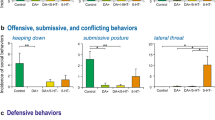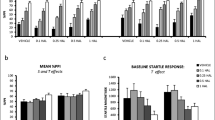Abstract
This study tested a behavior-suppressing punishment system and how its activity may be altered by agents known to interrupt or enhance serotonergic (5-HT) transmission. Holtzman male albino rats were tested for shuttle box avoidance acquisition and intertrial responding either 1 or 8 h following daily injections of fenfluramine (FEN) or fluoxetine (FXT). When the drug-test interval was 1 h, a time when both drugs are presumably potentiating 5-HT activity, avoidance acquisition and intertrial responding were impaired. When testing occurred 8 h after drug treatment, a time when 5-HT levels are unaltered by FXT and are maximally reduced by FEN, these drugs had no effect on avoidance acquisition, but FEN produced an increase in intertrial responses whereas FXT did not. These results support the proposal of an inhibitory 5-HT system. Furthermore, these data demonstrate that FEN is capable of exerting a biphasic action on intertrial responding and suggest that the time interval between drug administration and behavioural testing is a crucial variable when investigating FEN.
Similar content being viewed by others
References
Aprison MH, Ferster CB (1961) Neurochemical correlates of behavior. II. Correlation of brain monoamine oxidase activity with behavioral changes after iproniazid and 5-hydroxytryptophan. J Neurochem 6:350–357
Blundell JE, Latham CJ, Leshem MB (1973) Biphasic action of a 5-hydroxytryptamine inhibitor on fenfluramine-induced anorexia. J Pharm Pharmacol 25:492–494
Breese GR, Cooper BR, Grant LD, Smith RD (1974) Biochemical and behavioral alterations following 5,6-dihydroxytryptamine administration into brain. Neuropharmacology 13:177–187
Buczko W, DeGaetano G, Garattini S (1975) Effect of fenfluramine on 5-hydroxytryptamine uptake and release by rat blood platelets. Br J Pharmacol 53:563–568
Clineschmidt BV, Zacchel AG, Totaro JA, Pflueger AB, McGuffin JC, Wishousky TI (1978) Fenfluramine and brain serotonin. Ann NY Acad Sci 305:222–241
Clineschmidt BV, McGuffin JC, Pflueger AB, Totaro JA (1975) Fenfluramine-induced enhancement of confinement motor activity: An indirect 5-hydroxytryptamine-like action? Neuropharmacology 14:301–311
Costa E, Groppetti A, Revuelta A (1971) Action of fenfluramine on monoamine stores of rat tissue. Br J Pharmacol 41:57–64
Fuller RW, Perry KW, Molloy BB (1974) Effect of an uptake inhibitor on serotonin metabolism in rat brain: Studies with 3-(p-trifluoromethylphenoxy)-N-methyl-3-phenylpropylamine (Lilly 110140). Life Sci 15:1161–1171
Fuxe K, Farnebo LO, Hamberger B, Ogren SO (1975) On the in vivo and in vitro actions of fenfluramine and its derivatives on central monoamine neurons, especially 5-hydroxytryptamine neurons, and their relation to the anorectic activity of fenfluramine. Postgrad Med J (Suppl) 1:35–45
Geller I, Hartman RJ, Croy DJ, Haber B (1974) Attenuation of conflict behavior with cinanserin, a serotonin antagonist: Reversal of the effect with 5-hydroxytryptophan and methyltryptamine. Res Commun Clin Pathol Pharmacol 7:165–174
Graeff FG, Schoenfeld RI (1970) Tryptaminergic mechanisms in punished and nonpunished behavior. J Pharmacol Exp Ther 173:277–283
Posluns D (1962) An analysis of chlorpromazine-induced suppression of the avoidance response. Psychopharmacologia 3:361–373
Rowe H, Carmichael R, Oldham S, Horng JS, Bymaster FP, Wong DT (1978) Pharmacologic effects in man of a specific serotonin-reuptake inhibitor. Science 199:436–437
Stein L, Wise CD, Berger BD (1973) Antianxiety action of benzodiazepines: Decrease in activity of serotonin neurons in the punishment system. In: Garattini S, Mussini E, Randall LO (eds) The benzodiazepines. Raven, New York, pp 299–326
Vorhees CV (1979) Facilitation of avoidance acquisition in rats produced by p-chlorophenylalanine or p-chloroamphetamine. Pharmacol Biochem Behav 10:569–576
Wong DT, Bymaster FP, Horng JS, Molloy BB (1975) A new selective inhibitor for uptake of serotonin into synaptosomes of rat brain: 3-(p-trifluoromethylphenoxy)-N-methyl-3-phenylpropylamine. J Pharmacol Exp Ther 193:804–811
Author information
Authors and Affiliations
Rights and permissions
About this article
Cite this article
McElroy, J.F., Du Pont, A.F. & Feldman, R.S. The effects of fenfluramine and fluoxetine on the acquisition of a conditioned avoidance response in rats. Psychopharmacology 77, 356–359 (1982). https://doi.org/10.1007/BF00432770
Received:
Accepted:
Issue Date:
DOI: https://doi.org/10.1007/BF00432770




